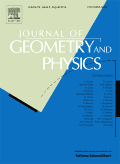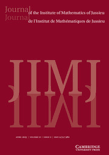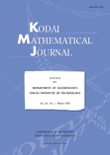
JOURNAL OF GEOMETRY AND PHYSICS
Scope & Guideline
Enhancing Our Understanding of the Universe Through Geometry
Introduction
Aims and Scopes
- Differential Geometry:
Explores the geometric structures and properties of manifolds, including Ricci solitons, biharmonic submanifolds, and curvature conditions, emphasizing their implications in mathematical physics. - Algebraic Structures in Physics:
Investigates the role of algebraic structures, such as Lie algebras and Hopf algebras, in formulating physical theories, focusing on their applications in quantum mechanics and field theories. - Geometric Analysis:
Studies the analytical aspects of geometric structures, including the analysis of partial differential equations on manifolds and the geometric flows, contributing to the understanding of various physical phenomena. - Symplectic Geometry and Mechanics:
Examines the symplectic structures that arise in classical and quantum mechanics, highlighting their significance in the formulation of Hamiltonian dynamics and geometric quantization. - Quantum Field Theory and Geometry:
Explores the geometric foundations of quantum field theories, emphasizing the interplay between geometry and physical concepts such as gauge invariance, topological features, and quantization methods. - Mathematical Physics:
Addresses the mathematical underpinnings of physical theories, including the study of solitons, integrable systems, and the geometric aspects of statistical mechanics and thermodynamics.
Trending and Emerging
- Geometric Flows and Solitons:
There is a notable increase in studies focusing on geometric flows, such as Ricci solitons and gradient solitons, reflecting a growing interest in their mathematical properties and applications in theoretical physics. - Higher-Dimensional Geometry:
Research exploring higher-dimensional geometric structures, including G2-manifolds and their applications in string theory and M-theory, is on the rise, indicating a trend towards more complex geometric frameworks. - Noncommutative Geometry:
The application of noncommutative geometry in physics, particularly in quantum field theories and string theories, is gaining prominence, suggesting a shift in how geometrical concepts are applied to modern theoretical frameworks. - Quantum Gravity and Geometric Structures:
Emerging themes in the intersection of quantum gravity and geometry are becoming more prevalent, indicating a renewed interest in understanding the geometrical aspects of spacetime at a quantum level. - Topology and Physics:
An increasing number of papers are exploring the connections between topology and physical theories, particularly in the context of topological field theories and their implications in various physical contexts.
Declining or Waning
- Classical Mechanics and Geometry:
While still relevant, the focus on classical mechanics as a geometric theory has waned, with fewer papers exploring traditional topics like geodesic flows or Hamiltonian systems in a purely classical context. - Elementary Particle Physics:
Research that directly links geometry with elementary particle physics has become less prominent, possibly due to a shift towards more abstract mathematical frameworks and higher-dimensional theories. - Standard Model Applications:
Papers specifically addressing applications of geometry to the standard model of particle physics have decreased, suggesting a shift towards more generalized or novel approaches in theoretical physics. - Geometric Thermodynamics:
The exploration of geometric methods in thermodynamics is less frequent, indicating a possible reduction in interest in how geometric structures can inform thermodynamic principles. - Topological Methods in Physics:
The focus on topological methods, while still significant, has seen a relative decline as researchers explore more complex algebraic and geometric structures.
Similar Journals

JOURNAL OF GEOMETRIC ANALYSIS
Bridging Theory and Application in GeometryJOURNAL OF GEOMETRIC ANALYSIS, published by SPRINGER, stands as a premier platform for the dissemination of high-quality research in the field of geometric analysis. With its ISSN 1050-6926 and E-ISSN 1559-002X, this prestigious journal has maintained a robust academic reputation since its inception in 1991, boasting a convergence of ideas and research that will continue through 2024. It is categorized in the top quartile (Q1) of Geometry and Topology, highlighting its significance and influence in the mathematical community. Ranking 23rd out of 106 in its field, and placing in the 78th percentile according to Scopus metrics, this publication is essential for researchers, professionals, and students who seek to deepen their understanding of geometric structures and their applications. Though it operates under a subscription model rather than Open Access, the journal consistently aims to advance knowledge through rigorous peer-reviewed articles that explore the latest developments and methodologies in geometric analysis, making it a pivotal resource for anyone involved in mathematical research.

Journal of the Institute of Mathematics of Jussieu
Advancing Mathematical Frontiers with Every PublicationJournal of the Institute of Mathematics of Jussieu, published by Cambridge University Press, is a leading academic journal that has established itself as a vital resource in the field of mathematics. With an impressive impact factor and a ranking in the top quartile (Q1) of miscellaneous mathematics, the journal serves as a platform for high-quality research from both established scholars and emerging researchers. Spanning from 2002 to 2024, the journal aims to foster collaboration and innovation in the mathematical community by publishing original research articles, reviews, and critical discussions on a wide range of mathematical topics. Although the journal does not offer open access, it remains widely accessible through various academic institutions and libraries, ensuring that critical advancements in mathematics are shared with a global audience. Located in the United Kingdom at the prestigious Cambridge campus, the journal reflects the rigorous standards of its publisher and the rich academic tradition of its home institution.

Journal of Symplectic Geometry
Unraveling the complexities of geometry with precision.Journal of Symplectic Geometry, published by INT PRESS BOSTON, INC, is a premier outlet for research in the rapidly evolving fields of geometry and topology. With an ISSN of 1527-5256 and an E-ISSN of 1540-2347, this journal has established itself as a vital resource for scholars, featuring innovative research and comprehensive surveys that delve into the intricacies of symplectic geometry and its myriad applications. Boasting an impressive Q1 ranking in Geometry and Topology for 2023, the journal is dedicated to fostering a collaborative academic environment, attracting contributions from esteemed mathematicians worldwide. While the journal maintains a subscription-based model, it continues to prioritize disseminating high-quality research that propels advancements in the field. Researchers, professionals, and students alike will find the Journal of Symplectic Geometry indispensable for staying updated on the latest developments and contributing to ongoing discussions within the symplectic community, spanning from 2009 to 2024.

Journal of Mathematical Physics Analysis Geometry
Unlocking the Secrets of Analysis and GeometryThe Journal of Mathematical Physics Analysis Geometry is a vital scholarly platform dedicated to the exploration and dissemination of research at the intersection of mathematical physics, analysis, and geometry. Published by the esteemed B Verkin Institute of Low Temperature Physics and Engineering of NAS Ukraine, this journal serves as a conduit for innovative ideas and new findings within these disciplines. Though currently classified in Q4 quartiles across its categories for 2023—Analysis, Geometry and Topology, and Mathematical Physics—it provides a unique opportunity for researchers to contribute to a growing field of study that remains crucial for advancements in both theoretical and applied mathematics. Since its inception in 2008, the journal has prioritized open discourse among academics, promoting accessibility to significant developments without the constraints of high publication fees. The Journal of Mathematical Physics Analysis Geometry invites researchers, professionals, and students alike to engage with its content and partake in the dialogue that shapes the future of mathematical inquiry.

JOURNAL OF DIFFERENTIAL GEOMETRY
Pioneering insights in geometry, algebra, and analysis.JOURNAL OF DIFFERENTIAL GEOMETRY, a premier publication by INT PRESS BOSTON, INC, has established itself as a leading forum for the dissemination of high-quality research in the fields of differential geometry, algebra, and analysis. With an impressive history that spans from 1967 to 2024, this journal is recognized for its rigorous peer-reviewed articles, contributing significantly to the advancement of mathematical theories and innovative approaches. Notably, the journal boasts a Q1 ranking in key categories such as Algebra and Number Theory, Geometry and Topology, and Analysis, reflecting its pivotal role within the mathematics community. Its Scopus rankings reinforce its reputation, placing it among the top-tier journals in its respective fields, with a 97th percentile ranking in Algebra and Number Theory, further emphasizing its influence. While the journal does not offer Open Access options, it remains a critical resource for researchers, professionals, and students aiming to stay at the forefront of developments in differential geometry and related domains. Engage with groundbreaking research and explore new methodologies that are shaping the future of mathematics.

Symmetry Integrability and Geometry-Methods and Applications
Pioneering Research in Symmetry and GeometrySymmetry Integrability and Geometry-Methods and Applications is a prominent open-access journal published by the NATIONAL ACADEMY OF SCIENCES OF UKRAINE, INSTITUTE OF MATHEMATICS, dedicated to advancing research in the fields of Analysis, Geometry and Topology, and Mathematical Physics. Since its inception in 2005, the journal has provided an esteemed platform for scholars from around the globe to share their innovative findings and methodologies, contributing to our understanding of complex mathematical concepts. With an impressive Q2 ranking in all three mathematical categories as per the 2023 Scopus rankings, the journal positions itself as a key resource for researchers seeking high-quality, peer-reviewed content. As a fully open-access publication, it ensures that research is readily available to a wide audience, fostering collaboration and knowledge exchange in the mathematical sciences.

Selecta Mathematica-New Series
Exploring the Depths of Mathematical and Physical Theories.Selecta Mathematica-New Series is a premier academic journal published by Springer International Publishing AG, based in Switzerland. With an impressive impact in the fields of Mathematics and Physics, it is recognized in the Q1 category for both Mathematics (Miscellaneous) and Physics and Astronomy (Miscellaneous) as of 2023. Established in 1995, the journal provides a platform for rigorous peer-reviewed research, facilitating the dissemination of groundbreaking findings and theoretical advancements through its converged publication years up to 2024. Researchers and scholars seeking to stay at the forefront of mathematical and physical sciences will benefit from the journal's diverse scope and high-impact articles. Although it does not operate under an open-access model, Selecta Mathematica-New Series remains a vital resource for building knowledge and fostering collaboration among professionals and students engaged in these dynamic fields. Access to its content is essential for those aiming to deepen their understanding and contribute to the ongoing dialogue within the scientific community.

COMMENTARII MATHEMATICI HELVETICI
Shaping the Future of Mathematics with Every PublicationCOMMENTARII MATHEMATICI HELVETICI, published by the EUROPEAN MATHEMATICAL SOCIETY, is a premier open-access journal in the field of mathematics, specifically categorized within the Q1 quartile of miscellaneous mathematics as of 2023. With an ISSN of 0010-2571 and an E-ISSN of 1420-8946, this esteemed journal has a rich history, having commenced its publication journey in 1929 and set to continue until at least 2024. Based in Germany, it provides a valuable platform for original research and significant advancement in mathematical theory and application, appealing to researchers, professionals, and students alike. The journal's commitment to open access since 2022 further enhances its accessibility and outreach, ensuring that cutting-edge mathematical developments are readily available to a global audience. Its Scopus ranking, which places it at the 165th position out of 399 in the general mathematics category (58th percentile), exemplifies its impact and relevance in the academic community.

Kodai Mathematical Journal
Fostering Collaboration in the World of MathematicsKodai Mathematical Journal is a distinguished publication dedicated to advancing the field of mathematics, particularly in miscellaneous areas. Established in 1949, this esteemed journal has been a reputable source for researchers and practitioners who seek to contribute to the rich landscape of mathematical knowledge. Published by KINOKUNIYA CO LTD, the journal is based in the academic environment of Tokyo Institute of Technology and serves a global audience with rigorous and insightful research articles. Despite its current Q3 quartile ranking in the Scopus Mathematics category, which reflects its niche but impactful contributions, the journal is poised for growth; the convergence of traditional and novel mathematical techniques promises to enhance its relevance further. Researchers, professionals, and students are encouraged to engage with the rich content of the journal, aimed at fostering collaboration and nurturing innovation in the mathematical community. While currently not available as Open Access, Kodai Mathematical Journal remains a critical resource for those passionate about mathematics and its applications.

International Electronic Journal of Geometry
Advancing Geometry Through Global CollaborationWelcome to the International Electronic Journal of Geometry, an esteemed platform dedicated to the dissemination of high-quality research in the fields of geometry, applied mathematics, and mathematical physics. Published by the INT ELECTRONIC JOURNAL GEOMETRY based in Ankara, Turkey, this journal serves as a crucial resource for scholars and practitioners eager to contribute to and stay informed on contemporary advancements in these disciplines. While currently categorized in the Q4 Quartile across multiple mathematical categories, the journal has consistently focused on fostering innovative research and providing open access to its content, although specific access options may vary. The International Electronic Journal of Geometry is known for facilitating scholarly dialogue and collaboration, aiming to enhance knowledge exchange within the global mathematical community from 2019 into the future. Whether through rigorous research articles or insightful commentary, this journal plays a vital role in promoting the understanding and application of geometric concepts and mathematical principles.